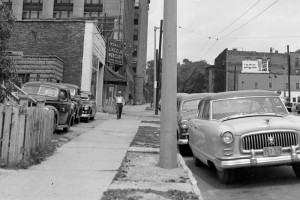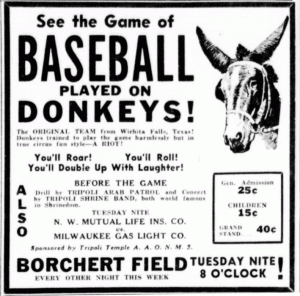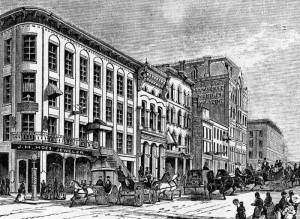From the Milwaukee Journal of August 18, 1935 comes this treasure.
This article highlighted many of the problems that were confronted when trying to figure out to do with the historic mansions of long-gone millionaires.
Milwaukee Journal, June 21, 1951
What to Do With Old Mansions?
Too Elaborate for Modern Living, Many Huge Showplaces Have Been Turned Into Museums, Schools and Religious Retreats, but It’s Not Always Easy to Find a Taker
A DREAM house of the past recently became a house of dreams for a brighter future when the 96 room Harriman mansion of Harriman, N. Y. — about 40 miles northeast of Manhattan — was taken over by Columbia university. It is to be converted into an “American Assembly” dedicated to “freedom and expression.”
The mansion — previously known as Arden House — was the gift of W. Averell Harriman, son of the original builder, Edward H. Harriman, railroad tycoon. Its career has been typical of that of hundreds of other great houses which the captains of industry built in the 1890’s and 1920’s to display their wealth and their taste, good or bad.
But not all the owners have been as lucky as W. Averell Harriman in getting rid of their mansions.
Take the case of Samuel Untermyer, who at 80, in 1938, tried to give Greystone, his beautiful estate overlooking the Hudson, to the city of Yonkers as a park. The city fathers, having no desire to forgo the rich haul in taxes and to shoulder the costs ot running the place, turned down the offer. Westchester county also refused him. And when, in his will, he bequeathed Greystone to New York as a state park, the legislature also rejected it.
Father Divine’s ‘Heaven’ on Hudson River
Untermyer had overlooked one possibility. He might have offered his place to the federal government, as did one of his neighbors Mrs. Louise Van Alen, farther up the Hudson. She had inherited the Frederick W. Vanderbilt estate just north of Hyde Park, with a mansion designed by Stanford White – and wanted to dispose of it. The only prospective buyer was Father Divine, and he was gracious enough to write to President Roosevelt before he closed the deal to find out whether the president might have any objections to the new Negro heaven so close to his own home.
When the president rather coolly informed Father Divine that he had always hoped the government would take over the property, Mrs. Van Alen offered it to the department of the interior and Harold Ickes, then secretary, enthusiastically added it to the national park system as “a magnificent example of the type of great estate built in the era of expansion that succeeded the war between the states.”
Shortly afterward, Father Divine, who already owned one of those old estates, procured another, the famous Krum Elbow on the western bank of the Hudson, directly across from Hyde Park, from Howland Spencer, an ardent Roosevelt hater. Three thousand black angels took up residence there, and Mrs. Roosevelt remarked in her daily column: “It must be pleasant to feel that in the future this place will be ‘heaven’ to some people, even if it cannot be to the former owner.”
About the same time – 1938 — another Vanderbilt palace, Idle Hour, on the famous 16 mile millionaires’ row on Long Island’s north shore, became the property of a motley group known as “the Royal Fraternity of Metaphysicians.” They rechristened it “Peace Haven” and began to train a boy there as a future messiah. Before those self-styled “Sons of Heaven” acquired the place, it had twice been sold to clubs but reverted to the Vanderbilt heirs by foreclosure.
A third Vanderbilt mansion, Biltmore House, erected some five miles from Asheville, N. C. in 1900 and often regarded as the finest private residence in America, is now a museum. Its builder. George Vanderbilt, was a collector of pictures, books and historical objects. His rarest piece was the chess table of Napoleon, with a drawer stained by the blood of Napoleon’s heart, which reposed there some weeks after his death.
‘Whitewings’ Picnicked at Otto Kahn’s Chateau
The story ot Otto Kahn’s flamboyant French chateau is often told. Among its 100 rooms was a dining room seating 200. After the death of this famous opera patron in 1934, his widow first offered the estate to the federal government as a summer white house.
Then, unable to find a buyer in five years, she decided to raze it, but the New York department of sanitation offerrd her $100,000 for it in the nick of time. Intended as a recreational center for the city’s street cleaners, it was renamed “Sanita Lodge” and opened with a picnic for 20,000 whitewings and their families. Then the village of Huntington stepped in with an injunction because the sanitation department had failed to obtain a building permit and a certificate of occupancy.
The department made another attempt to obtain the home of the late brewer, Jacob Ruppert, but was again repelled by local authorities. The Kahn property, meanwhile, was turned over to a real estate company, which subdivided it and made the chateau a country club.
In the course of years, big estates have been converted into old people’s homes, rest homes for industrial workers, research laboratories, factories, summer resorts, retreats or meeting places for religious organizations and swank private schools. Hyde Park became the repository of the Roosevelt papers and a gift to the nation.
Two estates had the unusual distinction of being rented by the Russians after the war as headquarters and recreational centers for their diplomatic personel. The Russians leased J. P. Morgan’s estate on Long Island in 1945 and evidently relished this symbol of capitalistic splendor so much that they leased the adjoining 800 acre “Glen Cove” the next year. Glen Cove was once the property of the Pratt family, whose founder, Charles, began selling Pratt’s Astral Oil Lamp fuel about the time Karl Marx finished writing “Das Capital.” He was Brooklyn’s richest citizen when he died in 1891. His son, George Dupont Pratt, conservationist, big game hunter, Boy Scout sponsor and collector, built the million dollar Tudor mansion Killenworth on the property. After his death the place was sold for taxes and thus came into the possession of the Miller Trunk Co., which used it for administrative headquarters until it was leased to Stalin and company.
With the coming of postwar prosperity, many of the great houses returned to their original uses as residences. One writer remarked in 1948 that just then they vere selling like ice cold beer in a 101 degree heat wave. The chief problem in running such a place is hat numerous servants are needed and the servant market is decidedly bearish.
Many of the earlier mansions were architectural monstrosities – crude imitations of robber baron castles on the Rhine like the Bannerman fortress on the Hudson, odd Dutch designs like Washington Irving’s Sunnyside (“full of angles and corners like an old cocked hat”) or gingerbread castles known as “Hudson river bracketed,” a phrase that became the title of a novel by Edith Wharton. Some were patterned after the classical style, correct in every detail from pillared porches to artificial ruins in the gardens.
Garish Living Wasn’t the Rule
The houses erected in the late nineties and thereafter were usually planned by the best architects and erected with considerable attention to artistry. Many of them could not be replaced today because the specialists who created and carved the mahogany trim and paneling, the rococco wall decorations, the floor parquetry and the tapestries are gone.
The great residences of the gilded age are usually associated with garish living — banquets on horseback, parties for dogs, all night affairs that began with Lucullan dinners, continued with cotillions, dancing and champagne suppers and ended with breakfast parties at sunrise. Randolph Guggenheim in 1899 gave a dinner, at $250 a plate, at which nightingales sang in transplanted rose trees and arbors hung with hothouse grapes. The liqueurs had been bottled before the French Revolution.
The high priest of this plush society was Ward McAllister, a Beau Brummoll who achieved celebrity by remarking to a newspaper reporter: “Why, there are only about 400 people in fashionable New York society.” When asked for the list, he submitted only 300 names, but the phrase “upper four hundred” stuck.
Actually most of the people who lived in these great houses were shy and ultraconservative. Their children were almost literally walled up within their estates, as the mother of Franklin Delano Roosevelt, who was one of them, once remarked to a friend. They associated among themselves — and still do — and intermarried, though a few more ambitious matrons courted foreign titles and married off their daughters to impoverished noblemen for a price. Most of them went to extremes to avoid publicity. Among the latter were the Harrimans, incidentally.
Few people today would care to return to the era of the fabulous fortunes that were necessary to build and maintain the great estates with their cavernous, splendid mansions. It is one of the good signs of our times that these pompous strongholds of class and wealth are being turned to public uses.
CHRISTOPHER MATTHEW
Wisconsin’s Lawsonia
Most famous of Wisconsin’s estates is 1,000 acre Lawsonia at Green lake. Victor Lawson, late publisher of the Chicago Daily News, and his wife lavished some eight million dollars on it early in the century. After their death, the property was acquired in 1925 by a Chicago corporation that planned to make a millionaires’ resort out of it. A fine 18 hole golf course was laid out and a swanky white brick hotel erected. During the depression it was in the hands of receivers, and the Northern Baptist association — now the American Baptist Assembly — bought it in 1943 for about $300,000 as a summer gathering place for church groups. The idea proved so successful that the assembly this year has undertaken a million dollar “face lifting” program that will make Lawsonia large enough to accommodate 1,500 guests at a time.
Today’s mystery photo is downtown and looks north. The Monart Lincoln Mercury service building is on the left and other apartment and office buildings are in the background. One building shown remains but I’ll leave it to you to determine which of those it might be. Lastly, this is sometime in the 1950s. Guess away!
Let’s go back to the 1930s for this mystery photo and somewhere on the edge of downtown. This is obviously an industrial area with plenty of railroad tracks running through. A track switching tender’s shack stands guard over the intersection. The building in the near background belongs to Milwaukee Scrap Metal Company. What is your guess as to where this might be?
Everyone has probably been waiting all day for this late edition of the Monday Milwaukee Mystery. This is a difficult one and the picture is downtown with only the building having the billboards as still existing. The time is sometime in the 1940s so everything is now quite different. Clues will come later unless someone takes a good guess! Where in downtown was this photo located?
We will keep the same format with this week by showing an old picture of a building. This picture shows a downtown building which is still around so some of you may recognize it. It looks just a little different than this and is somewhat well known. The picture gives some clues to narrow it down. Good luck in your guesses!

